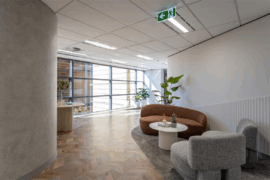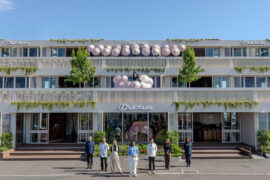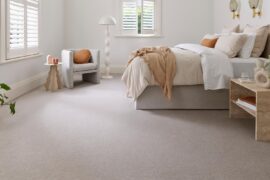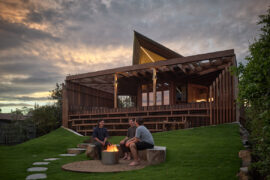Phillips by LAVA uses “intelligent lights” in the parametric designed ‘tree’ to boost communication, creativity, interchange and wellbeing for staff and visitors. Here’s how…
For the new HQ of Philips Lighting in the Netherlands, globetrotting architecture office LAVA was asked not only to provide innovative workspaces and an impressive reception area for receiving guests, but also to demonstrate the use of lighting to improve people’s lives.
“How light affects humans and how can we use it to create better living spaces,” says LAVA director Alexander Rieck, was therefore the inspiration behind the design, which revolves around a 3250m2 atrium dominated by an installation known as the Light Tree. ‘We thought about the experience of light. Light is only visible when it reflects on something, so we developed a multifaceted three-dimensional Light Tree ceiling with the qualities of light reflection, diffusion, and emission,’ says Rieck.
The ceiling installation has its roots in recent research by the Fraunhofer Institute on the effects of lighting on people, adds LAVA Senior Architect Nuno Galvão. ‘In Nature, the sun gives us a sense of time,’ he explains. ‘Working in an office means that people miss the subtle changes in light during the day. As research links levels of comfort and attentiveness to the human perception of such variations in our environment, we designed the Light Tree to filter and reflect the natural light from the atrium side windows and skylights.’ In addition to magnifying the effect of daylight, the installation feature warm light fixtures placed so as to emulate natural sunlight during darker days. These are programmed to embody the varying light effects of different seasons.
The installation consists of 1500 panels suggesting leaves on a tree, with a reflective surface on the back of each panel amplifying daylight and creating a play of light and shadow. Some 500 panels feature self-emitting Philips Ecophon Soundlight, a material combining LED lighting with integral sound absorption in a single system. After abundant preparation, including numerous co-creative meetings with the board and with actual users of the space at Philips, the final Light Tree took just three weeks to assemble on site.
The atrium (formerly the courtyard of the 1950s building) combines a number of social activities from a coffee bar to meeting rooms. Glass partition walls ensure that the effects of the installation are felt throughout the adjacent work environments, while wooden floors add warmth and tactility to the space. A core of naturally varying light thus illuminates and enlivens the HQ.
‘In our office, we take pride on pushing the boundaries of knowledge and practice,’ say Rieck. ‘We like to start with a theoretical approach and bring it to an architectural context. This project was one of those moments when we realized that we managed to make that a reality for everyone to experience.’
Want more? Grab a copy of Indesign #68 to read the full story!
INDESIGN is on instagram
Follow @indesignlive
A searchable and comprehensive guide for specifying leading products and their suppliers
Keep up to date with the latest and greatest from our industry BFF's!

CDK Stone’s Natasha Stengos takes us through its Alexandria Selection Centre, where stone choice becomes a sensory experience – from curated spaces, crafted details and a colour-organised selection floor.

Welcomed to the Australian design scene in 2024, Kokuyo is set to redefine collaboration, bringing its unique blend of colour and function to individuals and corporations, designed to be used Any Way!

London-based design duo Raw Edges have joined forces with Established & Sons and Tongue & Groove to introduce Wall to Wall – a hand-stained, “living collection” that transforms parquet flooring into a canvas of colour, pattern, and possibility.

A thoughtful, low-waste redesign by PMG Group in collaboration with Goodman has transformed a dated office into a calm, contemporary workspace featuring a coastal-inspired palette and Milliken flooring for a refined finish.

Making a splash on the hair spa scene, the latest project from X + O makes a little slice of Japan right at home in suburban Melbourne.

The World Architecture Festival has named The Holy Redeemer Church and Community Centre of Las Chumberas in La Laguna, Spain as World Building of the Year 2025, alongside major winners in interiors, future projects and landscape.
The internet never sleeps! Here's the stuff you might have missed

Melbourne interior designer Brahman Perera creates three-level trackside space exploring synthesis of craft and technology.

Good looks count, but function completes the space.

Recognised as a winner at the INDE.Awards 2025, Barton Taylor has received The Photographer – Residential accolade. His photographic work on Cake House captures the soul of a coastal icon reimagined, blending light, texture and atmosphere into a compelling visual narrative.